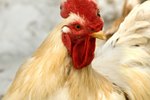Things You'll Need
Small cardboard box
Heating pad
Vaporizer
10-cc syringe
Electrolyte solution
Infant rice cereal
Baby food
Commercial parakeet pellets
Molasses
Papaya nectar
Parakeets are active and inquisitive pet birds. Through exuberant play, these little parrots can injure their wings and limbs. Parakeet toenails sometimes break and bleed and birds concuss themselves or injure their chests, by flying into solid surfaces when allowed out of their cages. Certain injuries, such as broken blood feathers, can be treated by the owner at home, but serious injuries, such as a broken limb or wing, will require veterinary attention.
Gently restrain the bird and apply a commercial veterinary powder to stop the bleeding, in the case of broken blood feathers and toe nails. If the bird is bleeding from the nostrils, mouth, vent or an open wound seek veterinary help.
Place a heating pad into a small box and turn it on. Adjust the temperature setting to 85 degrees Fahrenheit. Parakeets use energy to maintain their body temperature. By providing a heat source, the bird can better use this energy to deal with the stress associated with the injury. Place the parakeet in the box to restrict its movement and keep it quiet. Observe the parakeet very closely and turn down the temperature if the bird is panting. Adjust the temperature slowly, until that point where the parakeet stops panting and appears to be restful and calm. Once the bird begins to recover, lower the temperature gradually by 5 degrees a day until it reaches room temperature.
Place a vaporizer in the room with the bird if its breathing is labored. Parakeets with chest injuries may experience difficulty in breathing. A humid environment eases the bird's breathing and keeps the air passages open.
Fill a 10 cc syringe with an electrolyte solution, which is available from your veterinarian. Cradle the parakeet very gently in your one hand and carefully push the syringe nipple into the bird’s beak. Drip the electrolyte solution onto the parakeet's tongue. Ensure that you do not force fluid into the bird’s mouth, as it can easily get into the lungs and cause pneumonia.
Hand feed your parakeet small quantities of high-carbohydrate food items every few hours. Baby food and infant rice cereal are good choices. Grind up a high-quality commercial parakeet pellet and mix it with molasses or fruit juice, such papaya nectar.
Continue to hand feed and offer fluids until the bird begins to eat and drink by itself.
References
Photo Credits
-
Comstock/Comstock/Getty Images
Writer Bio
Virtually growing up in a computer repair shop, Naomi Bolton has held a passion for as long as she can remember. After earning a diploma through a four year course in graphic design from Cibap College, Bolton launched her own photography business. Her work has been featured on Blinklist, Gameramble and many others.





